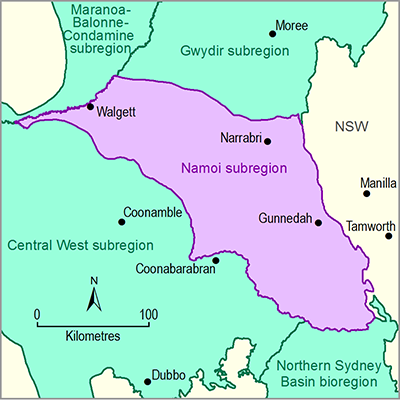Page 10 of 53
This geological model of the Namoi subregion is derived and adapted from pre-existing geological models that cover the Namoi subregion. The geological model is regional scale and therefore has a relatively coarse model resolution. The model was designed to isolate the layers that have important water-dependent assets (the alluvium and the Pilliga Sandstone) and the coal seams that are targeted in the Gunnedah Basin (the Hoskissons coal and Maules Creek Formation), and is considered fit for purpose for the Assessment. However, if the model were to be used for a different purpose, there are a number of geological data gaps that have been identified and would need to be addressed:
- The model does not contain faults and this is a limitation of the model. Depending on fault orientation, type and stress direction, faults can act to compartmentalise groundwater flow or provide a conduit for flow. There are distinct depositional sub-basins (e.g. Maules Creek and Mullaley sub-basins) within the Gunnedah Basin. The depth of these features can be in excess of 1500 m, and this is likely to be associated with faults or folding so a more detailed understanding of structures and inclusion in the model would improve geological modelling.
- There appear to have been some transcription errors between some WCR and the model database, resulting in the Hoskissons Coal in particular, being modelled as thicker than the reports and data indicate. It is recommended that the thickness of the Hoskissons Coal layer be reassessed if this model is to be used for other purposes.
- Access to WCR from other companies operating in the Namoi subregion would greatly improve the accuracy of geological models in the vicinity of coal project areas, particularly in the Maules Creek sub-basin.
- Access to more detailed geological mapping (including structural mapping) and geological models from other companies operating in the Namoi subregion would improve the model.
- The review of the CDM Smith model, which formed the basis of the Gunnedah Basin stratigraphy in the BA model, was limited, and input data to the model was not systematically validated. As the model used some non-open file well information from Santos, not all of the input data are publicly available and could not be verified.
- It is unclear how the tops of formations were picked in some wells. In some cases it appears they have been taken directly from the tabulated stratigraphy in the WCR, and in other cases from an interpretation of the composite logs in the WCR.
- There are some wells in the Namoi subregion that either have limited stratigraphic data, or for which data are not publicly available.
- Where well data is not available, for example in the south of the Namoi subregion, it may be beneficial to use the Phanerozoic OZ SEEBASE™ surface to constrain Gunnedah Basin surfaces.
- A detailed assessment of existing two-dimensional seismic reflection data, and well logs, and further incorporation of data from a variety of sources would improve this model. If available seismic and well log information is considered fit for purpose, it could be used for other purposes such as distribution and variation in lithology, porosity and more detailed structural analysis.
- An integrated geological analysis using regional geophysical datasets, well logs and coal company data is likely to provide further understanding on local-scale structures. A more detailed understanding of structures would improve geological and hydrogeological modelling.
Last updated:
6 December 2018

Summary and download
Product Finalisation date
2018
PRODUCT CONTENTS
- 2.1.1 Geography
- 2.1.2 Geology
- 2.1.3 Hydrogeology and groundwater quality
- 2.1.4 Surface water hydrology and water quality
- 2.1.5 Surface water – groundwater interactions
- 2.1.5.1 Observed data
- 2.1.5.2 Previous catchment-scale investigations on stream-aquifer interactions
- 2.1.5.3 Overview of controls on surface water – groundwater connectivity based on previous investigations in the Namoi river basin
- 2.1.5.4 Statistical analysis and interpolation
- 2.1.5.5 Gaps
- References
- Datasets
- 2.1.6 Water management for coal resource developments
- 2.1.6.1 Boggabri Coal Mine (baseline) and Boggabri Coal Expansion Project (ACRD)
- 2.1.6.2 Narrabri North Mine (baseline)
- 2.1.6.3 Narrabri South Project (ACRD)
- 2.1.6.4 Rocglen Mine (baseline)
- 2.1.6.5 Sunnyside Mine (baseline)
- 2.1.6.6 Tarrawonga Mine (baseline) and Tarrawonga Coal Expansion Project (ACRD)
- 2.1.6.7 Caroona Coal Project (ACRD)
- 2.1.6.8 Maules Creek Project (ACRD)
- 2.1.6.9 Watermark Coal Project (ACRD)
- 2.1.6.10 Vickery Coal Project (ACRD)
- 2.1.6.11 Narrabri Gas Project (ACRD)
- 2.1.6.12 Mine footprints
- References
- Datasets
- Citation
- Acknowledgements
- Currency of scientific results
- Contributors to the Technical Programme
- About this technical product
ASSESSMENT
ASSESSMENT COMPONENT
